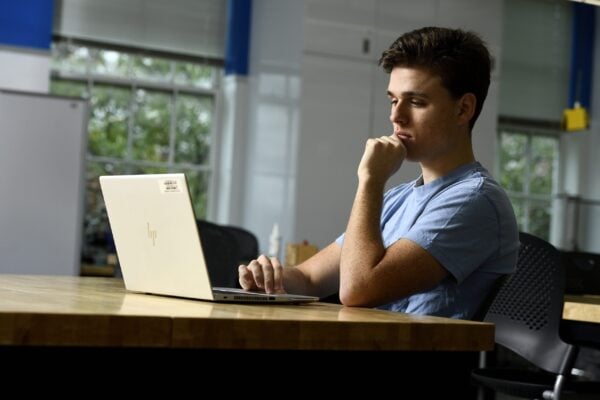Astronauts on future NASA missions will explore complex terrains on the moon and Mars wearing next-generation spacesuits designed to provide improved ranges of motion. However, these crewmembers’ increasingly demanding forays outside their vehicles put them at high risk of ergonomic injuries.
In an effort to prevent such injuries, fourth-year biomedical engineering student Rene DeBrabander spent his fall semester interning with NASA Johnson Space Center’s Applied Injury Biomechanics team, designing experiments to test motion-capture gloves, which are equipped with an array of sensors that capture data related to hand and finger movements. The team wants to use motion-capture technology in fully suited experiments, but first needs to prove that the gloves can produce viable data.
“The goal of my research is to determine the validity of motion capture, or mocap, glove implementation in a pressurized suit environment. I designed experimental procedures to compare data collected from a pair of mocap gloves in two environments,” says DeBrabander, who worked remotely from the Homewood campus.
In both experiments, the subjects perform tasks that involve pulling, grasping, twisting, and shoveling—the most common motions astronauts perform in space. In the first, the subject carried out those tasks while wearing the mocap gloves. In the second, the subject completed the motions with their arms inside a glove box—a sealed container with built-in suit gloves commonly used for astronaut-dexterity training.
Once the data from each was collected, DeBrabander used a dynamic time warping algorithm to align it and calculate averages for each test. A statistical analysis then helped him determine similarities between the control and experimental data.
In order to provide ergonomic feedback to astronauts and predict risk in real time during activities they conduct outside of vehicles, it will be necessary to monitor their motions via wearable sensors, says DeBrander. “Real-time monitoring of suit motions can be used to inform the crew of potentially hazardous ergonomic positions and movements, as well as allow for prediction of metabolic burden. The work I am doing is the first step toward implementing real-time motion capture technology in a suited environment.”
DeBrabander worked closely with two mentors at Johnson Space Center during his internship. Biomechanical specialist Nathaniel Newby helped him create a protocol that balanced subject safety and data acquisition to ensure a safe and effective experiment. Kyoung Jae Kim.is a human performance data engineer who helped DeBrabander conduct experiments and develop software used to analyze motion capture data.
“These mentors have been the best part of my internship,” says DeBrabander.

